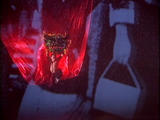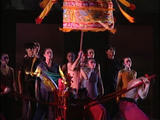|

ed2k: спектакль.avi
ed2k: русские субтитры.srt
ed2k: английские субтитры.srt
ed2k: китайские субтитры.rar
История Тайваня полна драматических событий: колонизаций, оккупаций, революций, культурных и межэтнических противоречий. В 1997-ом году Линь Хуай-минь решил посвятить один из спектаклей его замечательного театра "Юньмэнь" темным страницам недавней тайваньской истории. Так возникли "Семейные портреты", смесь современного и фольклорного танца, пантомимы, пластического театра и документалистики.
Звуковое оформление спектакля состоит в основном из звучащих за сценой интевью с обычными людьми, пережившими тягости тайваньской истории. Ну и (по старой дружбе) я перевел китайские субтитры на русский и английский. К слову, театр "Юньмэнь" выступит в этом году с гастролями в Москве (а также в Европе, США и т.д.): http://www.cloudgate.org.tw/eng/english/iframe/schedule.htm
| QUOTE |
| СЕМЕЙНЫЕ ПОРТРЕТЫ 1. Танец льва 2. Купание 3. Невеста 4. Женщина в белом 5. Мытье волос 6. Пеон 7. Умывание (I) 8. Молящаяся женшина 9. Девушка с длинными волосами 10. Плавание 11. Чистка зубов 12. Женщина в черном 13. Священная повозка 14. Танец-транс 15. Сожжение жертвенной лодки 16. Засада 17. Умывание (II) 18. Плывущие фонарики в память усопших |
| QUOTE |
| CLOUD GATE DANCE THEATRE OF TAIWAN PORTRAIT OF THE FAMILIES Choreography Lin Hwai-min Music Arvo Part Nan Kouan (Classical music of Southern China) Ha Ka Traditional Music Excerpts from the interviews Set Design Ming Cho Lee Lighting Design Lin Keh-hua Slide Projection Design Elaine McCarthy Slide Projection Consultation Wendall Harrington Photo Consultant Chang Chao-tang Costume Design Chen Wan-li Technical Design Richard Loula Interviewer Lu Chien-ying and Reporters of "Report of Survey" at Super TV Channel Duration 100 minutes with no intermission Programme Family Portraits Lion Dance Bathing The Bride The Woman in White Washing Hair Peony Washing Faces (I) The Woman Who Prays The Girl with Long Hair Swimming Brushing Teeth The Woman in Black Holy Carriage A Trance Dance Burning the Sacrificial Boat The Ambush Washing Faces (II) Floating Lanterns for the Dead ABOUT PORTRAIT OF THE FAMILIES "An epic dance Saga."---The Taiwan Newspaper "An aesthetic declaration of Independence." ---Frankfurter Allgemeine Zeitung In 1895, Taiwan was ceded to the Japanese by China at the conclusion of a bitter Sino-Japanese war. During the ensuing 50 years, Japan ruled Taiwan with an iron fist, forcing the residents of the island to adopt Japanese customs, clothing, and even Japanese names. During World War II, thousands of Taiwanese were conscripted by the Japanese to fight the Chinese. At the conclusion of the war, with the defeat of Japan, Taiwan reverted to Chinese rule. This created a dilemma for the people of Taiwan. They were now under the control of the Chinese Nationalists, who had only recently been on the other side of the firing line. In February of 1947 there was an island wide massacre in which many intellectual elite and political leaders of the Taiwanese were murdered. Martial law descended upon the island, and would remain in place for 40 years. During these dark years, the Taiwanese were suppressed and gagged. Nobody dared to speak of recent history, and all family records and photos were secreted away. To have a photo discovered of anyone wearing a Japanese kimono would result in being labeled un-nationalistic, or un-patriotic. To be heard speaking the Taiwanese dialect in school was to invite punishment or penalty. Political dissidents were put into prison or simply "disappeared". After martial law was lifted in 1987, some of these old photos and family histories began to be unearthed. People were finally free to explore their own heritage, and the history of Taiwan is now being rewritten. Choreographer Lin Hwai-min describes his first experience of seeing pictures of his parents and his ancestors since the 19th century as being extremely traumatic. He began to collect old photos from all walks of Taiwanese life, and to research the stories behind these photos. Out of the more than 2000 pictures in his collection, he has chosen about 1000 to serve as the backdrop for Portrait of the Families, the full length work inspired by these photos. Lin claims to be haunted by these images of people, especially the victims of the 1947 massacre, whose very existence had been wiped out by political force, and decided to examine these turbulent events from the point of view of the family... (http://www.cloudgate.org.tw/eng/english/pop/families_text01.htm) |
| QUOTE |
| Lin Hwai-min on Portraits of the Families: "...It was not until 19 years after "Legacy" was created that I more or less solved the puzzle of how to move on stage in a work that attempts to reclaim the lost memories of Taiwanese. It was called "Portraits of the Families". Jennifer Dunning, the senior dance critic for the New York Times, once asked me that while most choreographers created works about their families, their father, or their dogs, they created in short, out of their lives, why I often chose to address political issues? I told her that I never thought about political issues, my works merely reflected my own life. There has been through drastic changes in Taiwan in the past two decades. 1987 saw the lift of the Martial Law. The first direct presidential election took place in 1996. And in 2000, the Nationalist Government that had ruled the island for more than 50 years was voted out from power. With each change, people were empowered new freedom. And information from the past was unearthed. "We are not reviewing our own history," I told Ms. Dunning; "We are discovering and learning about it and about ourselves." Ideas for "Portraits of the Families" were triggered by old photos of Taiwan. In big cities throughout the world, there are always pictures and postcards of cityscape and people from yesteryears. Not in Taiwan, at least not until 15 years ago. When I was a little kid, I once discovered my mother's photo album from a closet. Several photos showed her wearing the Japanese kimono, apparently taken before the arrival of the Nationalist Government when Taiwan was still ruled by Japan. Mother looked so beautiful. I was very excited. But my mother simply took it away from me. I never saw the album again. Under the Martial Law, fear transformed itself into numerous taboos that cast shadow at each turn of life. As Japanese were the enemy of Chinese during the War, my mother was not the only person who thought that anything related to the Japanese era had to be hidden away. In the early 90s, the folks in my hometown dug out their family collections and held a grand photo exhibition. For the first time in my life, I got to see the faces and major events of my hometown in the past 100 years. I was so overwhelmed by the experience that I wanted to share it with the people in Taiwan by projecting old photos on the backdrops in my new work. But, what should be the content of the work? I recalled those hushed conversations by the adults in the late evenings which often terrified me in my childhood. I remembered the widow of my father's cousin who disappeared after the massacre, and that her hair turned gray when she was only 30 years old. I decided to tackle the darkest years of Taiwan, about the massacre in 1947 and the White Terror in its aftermath. We interviewed family members of the victims in the massacre, of those who were shot without trials and those who simply disappeared. Their voices in mandarin and different dialects became the soundscape of the work. And, since "Portraits of the Families" was a work about cleansing, I forsook dance technique and had dancers do gestures and movements from everyday life: washing face, washing hair, washing body, washing hands and other simple movements. It took the form of collage, no linear development, no specific roles, while the projected images and voices were so realistic, dance was almost abstract. I was happy with what we had done: the dancers in contemporary clothes looked like people in the street and their movements evoked no resemblance of the western modern dance. At the premiere, audience was shocked. For the great majority of them, it was their first encounter with such images and voices from the past. History was no longer several lines in words. There was a tension of resistance in the theatre that gradually gave into tears and sobs. "Portraits of the Families" was meant to be a "family affair," and was never intended for export. Nevertheless, we soon got invitations from festivals in Jerusalem, Vienna and Berlin. I became worried. Few people in the West would know the history of Taiwan and surely nobody could understand the material in the soundscape. And yet it had to be understood! We had all the voices translated and invited people with suitable English accent for each voice to do the recording. "Portraits of the Families" had its overseas premiere in Jerusalem. Twenty minutes after it had started, I had to leave the theatre. With English echoing in the theatre, the work looked weird and hollow; I could no longer recognize it. In panic, I called the director of Vienna International Dance Festival and asked her if I could present the un-translated version. No problem, she said. And she would provide English script for those who wanted to know the details. All set. But, anxiety possessed me again. Wouldn't that mean the work might be misinterpreted or not understood at all. I could not sleep. Then, one night I sat up in my bed. What the heck, I told myself. The Italians never translated the lyrics of Puccini's arias for us, yet that did not stop us from falling in love with Mimi or La Traviata. I decided to stick to the original version. Still, it turned out to be the most nervous, if not the most scaring, opening night in my life. Ten minutes before curtain, a lighting operator miss-pressed a button on the computer and all the lighting cues disappeared. The performance was delayed. Worse, it happened to be the hottest day in 30 years in Vienna, 38 degree, and there was no air condition in the theatre. Audience waited patiently using program books as fans. Makeup started to melt on beautiful faces. 50 minutes later, computer recalled its memory. . . . In the steaming heat, the Taiwanese tragedy unfolded smoothly and, at the end, received a rousing standing ovation. Dozens of people even lined up in the backstage to congratulate and thank me. "It was sadly beautiful," they said. "Yes, we understood it perfectly well. We also have our share of darkness in our history," a gentleman told me. "But, it was not confronted in our theatre." That evening I consumed two bottles of red wine by myself. Deadly drunk, I paced around in my hotel room, weeping and wailing. For years, we strove for creating works that were ours. "Portraits of the Families" did just well..." (http://www.ispa.org/ideas/lin.html) |
| CODE |
| Runtime ......................: 01:42:22 Video Codec ..................: XviD Frame Size ...................: 640x480 FPS ..........................: 29.97 Video Bitrate ................: 814.0 kbit/s B-VOP, N-VOP, QPel, GMC ......: [B-VOP]...[N-VOP]...[QPel]...[] Audio Codec ..................: mp3 Audio bitrate ................: 133 kbit/s [2 channels] Language .....................: Taiwanese, Mandarin, Hakka, Yami (aboriginal Taiwanese) Subtitles ....................: Chinese, English, Russian |



